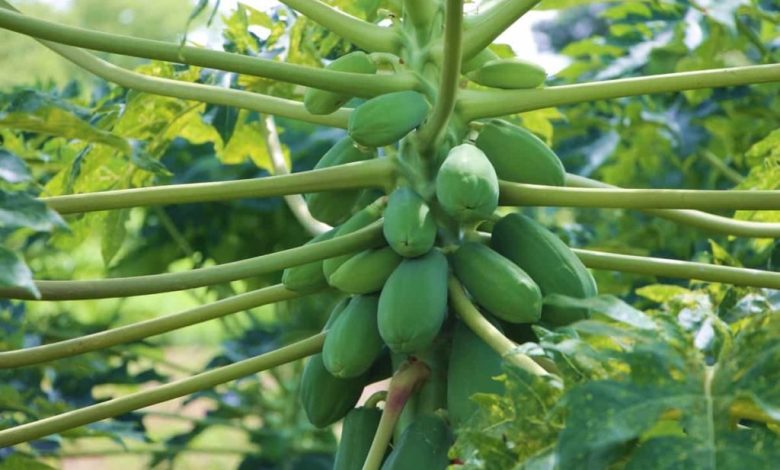Agronomy: How you can increase papaya yield

Papaya production is of great importance because of its high nutritional and medicinal value. Papaya is a tropical fruit. It is a very productive and interesting crop.
It is easy to grow as a short-term crop. As raw fruit it is used for cooking and some preparations. Below Seeds of Gold lists the steps to boost papaya growth.
Soil management
High fertile soil with good drainage is most required for successful cultivation of papaya. The crop grows well in sandy loam soils with pH between 6.5 and 7. Papaya grows under a wide variety of soils. However very shallow and very deep dark soil is not suitable for papaya cultivation. Fertile well-drained and lime-free soil is preferred for better fruit growth.
Growing conditions
Papaya is planted during (March and April) and the plant requires large amount of fertiliser and manure. The flowers of the papaya crop thrive in humid and hot climates. Exposure to extremely low climates can damage the leaves and even kill the plant.
Land preparation
A well-drained upland is selected for cultivation. In open and highlands, plants are exposed to strong winds. Therefore strong windbreaks should be applied around the boundaries of the papaya garden.
Proper spacing
1.8 by 1.8-metre spacing is usually followed. However, higher density cultivation with an interval of 1.5 by 1.5 metres per hectare increases the profit to the farmer and is recommended.
Propagation
Generally, papaya is gown from the seed. Dried seeds can be stored in airtight bag refrigerated for one year or more. Fresh papaya seeds germinate in 10 to 14 days.
Transplanting is usually limited to arrears with reliable rainfall or available irrigation. When sowing directly, 10 to 15 seeds are sown at half inch depth in each plant hole.
Approximately 0.5 cubic feet of soils should be added to each planting hole. Soil helps to maintain fertiliser nutrients and moisture.
Intercropping
Anyone can do intercropping in papaya cultivation. Firstly grow a variety of short-term vegetables for about six months after planting papaya.
Seed rate
Seed and tissue culture plants commercially propagate it. Approximately 250 to 300 grammes of papaya seed is sufficient for one hectare of planting.
Fertiliser
The papaya plants needs large amounts of fertilisers and manure. NPK is the most recommended fertiliser.
Newly planted papaya need phosphorous for proper root formation. So it is good to fertilise the papaya tree before planting.
Papaya trees are relatively less caring but that does not mean they do not need suitable fertilisers to grow fast and grow well. A balanced carbon/nitrogen ratio is necessary for proper fruiting.
Compost for fruit growth
It is good to use compost to feed papaya trees directly from essential nutrients including nitrogen. Compost helps improves drainage and creates better soil conditions for papaya trees. Add two parts of fertiliser to the bottom before planting your papaya tree. It would help if you fertilised regularly to help the papaya tree grow properly.
Proper watering
Papaya has large leaves. During a dry season, a lot of water evaporates through them. Therefore it is essential to provide plenty of water to your plants especially during the early stages of development.
However over-watering is also a significant problem leading to root-rot. This problem often occurs during the wet season when evaporation levels subsidise. In addition, papayas are very sensitive to the accumulation of water caused by heavy rainfall in non-porous soils. It is better to choose a slightly slopping field than a perfectly level field in such cases.
Proper irrigation
Make a proper watering plan based on the current climate and soil condition to help your plants grow best.
For optimal growth of young plants and good production of bearing plants, papaya should be irrigated to meet the required rainfall. When rainfall is limited, farmers can apply 10 gallons of water per plant per day.
Weeding
Good weed control methods can also increase yields. Weeding in the papaya garden is mostly done by a hand hoe. Fruit thinning is also necessary to regulate production and improve uniform size marketable fruit percentages. After the fruits set, the early stages of fruit development are much faster.
Therefore any fruit that remains undeveloped for a week or so in a row is unlikely to be marketable.
Poor growth is usually due to poor pollination and fertilisation. Such fruits are generally smaller and should be picked early by the farmer.
Harvesting
Papaya harvesting should be done after the colour breaks. When some yellow colour is shown on the fruit but before it is entirely yellow. If left on the papaya tree to ripen, the fruit is often damaged by pests such as birds and flies.
Pests and diseases
Root rots can cause rapid death of papaya plants. The only solution is to plant new plants in a better place with better drainage. Watering should be done carefully. Viral diseases are quite common and uncontrollable. They usually clear the veins and cause yellowing of the leaves. Other symptoms include distorted leaf development with stagnation, poor set, and the presence of various greasy or yellow circles on the leaves and fruits. Infected plants should be removed and destroyed. The common whitefly is just about insect-infected papaya forming a sooty mold on the fruit. Sweet potato whitefly is also reported to like papaya. The safest control is spraying with soapy water.







